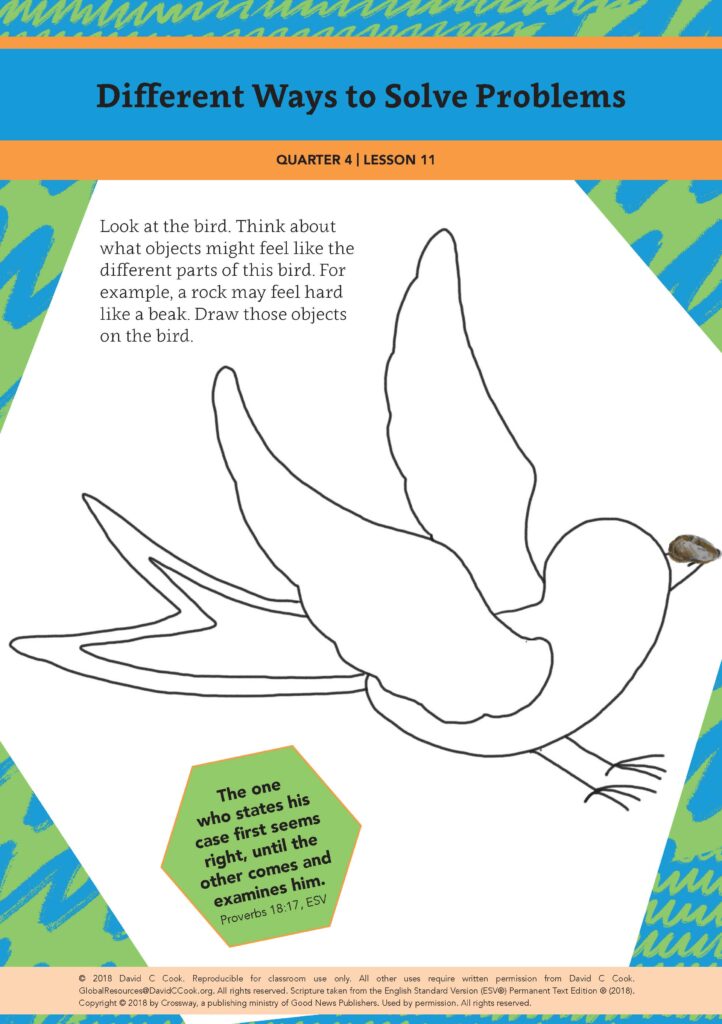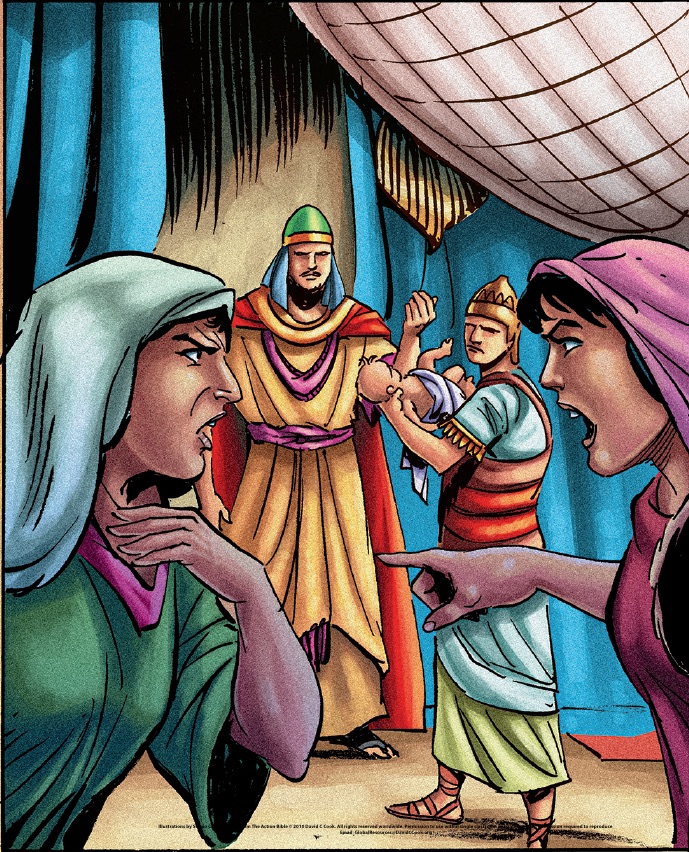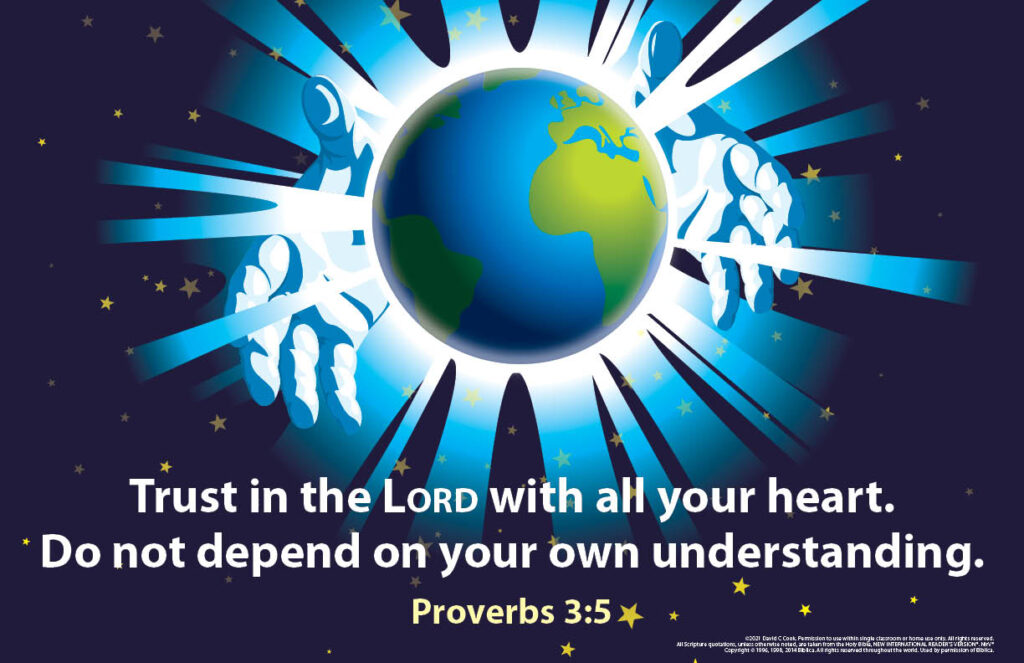During the lesson, the information for you to know is written in regular type, and what we suggest speaking or reading aloud to children is in bold. All resources for this lesson, including the Teacher Guide, Student Page, Family Connection Card, and other resources can be downloaded in a ZIP file by clicking on the following link:
In some lessons you will find "resource articles." These are articles written by experts from around the world to help equip you for your work with children and adolescents. Share them with parents or guardians if you consider it appropriate.
You want to do what is right and fair when you judge people. Because that is what you have asked for, I will give it to you. I will give you a wise and understanding heart. So here is what will be true of you. There has never been anyone like you. And there never will be.
1 Kings 3:11b–12
We all have problems. They are a direct result of sin. Some problems are easy to solve while others are not. In this verse, God gives King Solomon wisdom. Solomon knew that being king meant having to settle other people’s disputes as well as his own. As an adult who looks after children, you too may find yourself helping children to resolve their arguments.
Whatever problems you and your children face, know that God will provide the wisdom necessary to help you solve them. Sometimes you may need to look at more than 1 solution to a problem before you can solve it. When you ask for the Holy Spirit to guide your thoughts and actions, He will. May God give you a wise and understanding heart to help guide your decisions and solve your problems.
Encourage the children to talk to their families about something they have done that took more than 1 try to get right.
Teacher Tip: If possible, email or text the Family Connection Card to the families of your students.
Greet the children as they enter the teaching space and ask each to name 1 problem-solving step. Then, ask them to sit in a circle. When you join the children in the circle, bring the stones, soft material, leather, and sticks with you.
We have been talking about solving problems. Today, I have a problem and I need you all to help me solve it. Would you like to help me?
I have some objects here that we will pretend are all part of an animal. You must work together to figure out what type of animal it is. Pass this stone around the circle. Close your eyes as you feel the stone. Note whether it is hot or cold, smooth or rough, and hard or soft. There are 4 stones in all and they are the first clue.
Give the children time to pass 1 of the stones around the circle.
Answers may include: hard, smooth, and cold.
Let’s look at all of the stones.
There are 4.
Place the stones on the ground as if they are the hooves of a deer. Place 2 together toward where the front of the animal would be and 2 together toward where the back of the animal would be.
Answers may include: goats, sheep, deer, antelope, gazelles, or other hoofed animals.
We will need to look at the other clues to decide what our animal is. Next, let’s look at the small piece of leather. Let’s pass the piece of leather around the circle.
Now let’s pass this soft piece of material around. We will pretend it is an animal’s tail.
Allow 2–4 children to respond.
Now you are getting closer to figuring out what animal we are pretending this is! We have 1 more clue to help us solve our problem—the 2 sticks. Let’s pass the 2 sticks around the circle.
Answers may include: bumpy, rough, smooth, pointy, etc.
Answers may include: goats, antelope, gazelle, deer, and other similar animals.
Great! Now let’s put all of the pieces together.
Allow 3–4 children to respond. If the students get stuck, guide them with hints about the animal you thought of at the beginning of the activity.
Thank you for helping me with my problem. It appears that there is a deer with us in our teaching space!
Optional: If you are using Student Pages, ask the children to use crayons to draw their objects on the bird.

In life, it is not always easy to solve problems. Sometimes you may have to try to solve a problem many different ways before you find a solution. Some big problems may not ever be fully solved. But God helps us even when problems do not go away.
Allow 2–3 children to respond.
Have the children hold up their fingers for each step, just as they did in Lesson 10.
You have learned 4 steps to help you solve problems, but what happens if your first solution does not work? There is 1 more step to help you when this happens.
Step 5: Try other solutions.
There will be times when you choose what you think is the best answer and it does not solve the problem. There will be other times when you choose a solution and it works the way you want it to. Sometimes problems can be very difficult. In a courtroom, both sides of a story are told. Listen to what the Bible says about figuring out what is the right information to help you solve a problem.
Read this verse directly from your Bible.
The one who states his case first seems right, until the other comes and examines him.
Proverbs 18:17, ESV
You may sometimes think that you have a solution to a problem when you actually need more information to decide how to solve it. So how do you find the correct answer to a problem if the first thing you try does not work? Use step 5 and try other solutions.
In a true story from the Bible, King Solomon knew he needed help to make good decisions. So, he asked God for wisdom to help him make decisions. Listen to what God said to King Solomon.
You want to do what is right and fair when you judge people. Because that is what you have asked for, I will give it to you. I will give you a wise and understanding heart. So here is what will be true of you. There has never been anyone like you. And there never will be.
1 Kings 3:11b–12
God did as He said He would because God always keeps His promises! He helped King Solomon to grow in wisdom because God knew Solomon would need it to help others in a fair way. Since Solomon was the king, people came to him to solve their problems. King Solomon was already wise in asking God to help him understand things in a way that others do not. In this way, he completed the first step of problem-solving (hold up 1 finger).
The Bible tells of a time when King Solomon helped to put a baby boy back in the arms of his mother. In the true story, 2 women were arguing over the baby. Both women claimed to be his mother. Solomon gathered information from both women, but he still was not sure which woman was the baby’s mother. Solomon tested both women so that he could figure out which was the mother. The test worked, and the baby was given to his mother! God gave Solomon wisdom, and Solomon used it to solve problems.


God made all of us with minds that seek wisdom. When we ask Him, God can provide us with wisdom, just as He did with Solomon. When you think a problem is too difficult to solve, stop and ask God to give you wisdom. Then, use the mind He gave you to think of different ways to solve the problem.
In the animal activity you did today, you first looked at each object separately. When you looked at the objects and considered how each of them felt, you only saw part of the solution to the problem. When you thought about the objects together and tried to think of an animal that included each part, it helped you to solve the problem.
It is okay if you cannot solve a problem the first time you try. You can look at the problem a different way and try again!
Let’s review all the steps for solving problems.
Pray for understanding (children hold up 1 finger) Identify the problem (children hold up 2 fingers) Gather information (children hold up 3 fingers)
Try to solve the problem (children hold up 4 fingers) Try other solutions (children hold up 5 fingers)
Let’s play a drawing game! For this game, I will split the class into 2 teams. This side of the teaching space (indicate 1 side) is Team 1, and this side (indicate the other side of the space) is Team 2. I will choose a child from each team. I will whisper to these children a description of a picture to draw. As the child draws, the rest of the team will try to guess what the picture shows. Your team might not guess the correct answer right away, so you will have to continue guessing what the picture is. If you are drawing and your team does not guess correctly, you may have to draw a new picture. The child who drew the picture for the team that guessed correctly will choose 1 child from each team to draw the next picture.
Choose from the following scenes, or use your own ideas. Choose scenes your children will be likely to see in their daily lives. If you make up your own scenes, make sure they are simple things that the children will be able to draw. Here are a few ideas:
Select 1 child from each team to draw first. Give each team 1 stick to use to draw in the dirt. Continue playing for 3–5 minutes.
Optional: If you have 8 pieces of paper and some crayons available, use these instead of drawing with sticks on the ground.
That was fun! You all did a great job figuring out what the pictures showed. Our memory verse today reminds us to ask God for help when we solve problems.
Show the Memory Verse poster, if you are using it.
Trust in the Lord with all your heart. Do not depend on your own understanding.
Proverbs 3:5

Trust in the Lord—Grasp hands together.
With all your heart—Cross arms with palms over your heart.
Do not depend on your own understanding—Indicate no while touching the sides of your head with your index fingers.
End class by saying this blessing, based on 1 Kings 3:11b–12, over the children.
Blessing: May you ask God for wisdom. May you seek to do what is right and fair. May God give you wisdom and understanding when you face a problem.
Lead the children in singing this quarter’s song if possible.
Life on Life ©2020 David C Cook. Reproducible for home or classroom use only. All other uses require written permission from David C Cook [email protected]. All rights reserved.